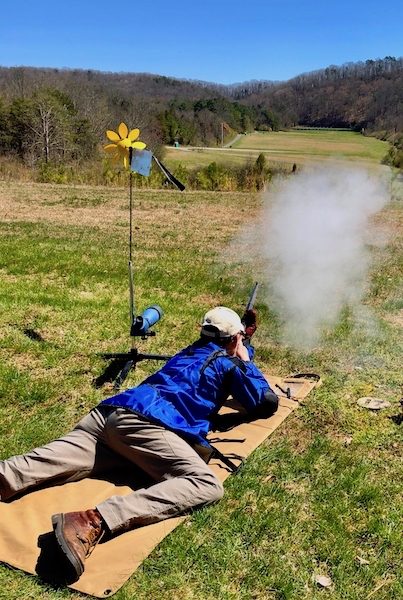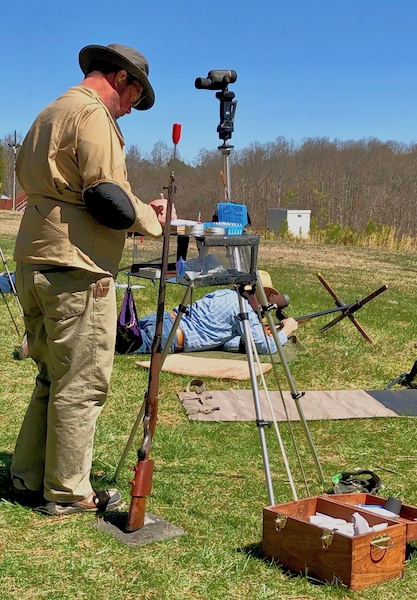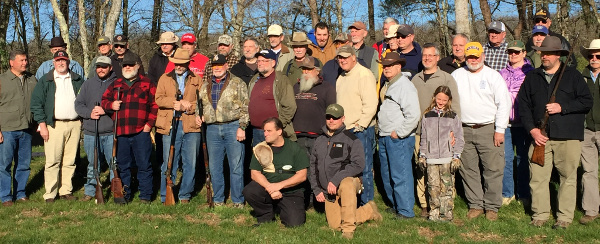Let me begin by saying that this year, and the next four years, Rick Weber, with the blessing of the Oak Ridge Sportsmen’s Association (ORSA), will be hosting a different event than he normally does. 2024 will be the 150th anniversary of the well known International Competition of 1874. A match between the Irish rifle team and a scratch team of eager American marksmen bent on winning honor, in what was then, the greatest spectacle on Earth — long range marksmanship.
The first match at Creedmoor was the answer to the invitation of the then World Champion Team from Ireland. It was to be held on a new range, constructed for that purpose, at Creedmoor Long Island. If you have not heard of the Creedmoor match of 1874, you should start at David Minshall’s website and get yourself educated. Read the articles titled “The Creedmoor Era”. Take your time, I will wait. When you are done there, if you find you want to know more, you can find the whole story in a report written to immortalize the event. It can be bought at Amazon as Report of Executive Committee of the Amateur Rifle Club on the International Match. It is available as a free PDF download as well, at Archive.org.
The Creedmoor target as used in 1874, is 12 ft wide by 6 ft tall and is divided into a bullseye, a center, and two outers. The bullseye, painted black, was 3 ft by 3 ft square. The center, painted white, was 6 ft by 6 ft square. An outer on each side was white as well, and measured 3 ft by 6 ft. Scores were; bullseye for 4 points, center for 3 points, and outers for 2 points. Targets were shot at 800, 900, 1000 yards. Fifteen shots at each distance with no sighter shots.
Now, the target above may not look that spectacular to a modern day marksman, but keep in mind their rifles were the best and most perfectly constructed mechanisms — of the day. There were no computer automated wizbang super-be-dooper gun making machines pooping out 1 MOA rifles at the rate of a hundred a day. These were hand built rifles, made by skilled craftsmen, when the name craftsman did not refer to a quaint old man at a Renaissance Fair.
To add even more mystique to the ability of these men, they did not have a weather station app or ballistic calculator on their iPhones. Only iron sights were allowed, no bench rests or even slings were used, and they had but a few weeks practice shooting at distance. Many of the American team had never shot beyond 200 yards until the summer of 1874. Yet, they accepted the challenge from the current World Champions without hesitation. Then, they won.
It was a big deal then, and it still is today.
In 2024, Rick Weber and ORSA will be hosting a 150th anniversary event of the 1874 Creedmoor match to honor those gallant men who accepted the challenge of competing against the world class shooters of the day. The next few years will be a lead into that event. An opportunity for everyone to prepare and for Rick to sort out the details of hosting what is certain to be a wonderful match. If you are interested in LRML, or Black Powder Cartridge Rifle (BPCR), you have time to get ready. It is muzzleloaders against breechloaders all over again.
Now, to the first of these matches, shot this past March 22nd and 23rd. I cannot say I had an excellent score, not even an average score. But, I managed the rifle well and shot with confidence both days. My efforts these past few years have not been wasted. I cannot draw a direct comparison between my past scores and my last scores, as we shot a Creedmoor target instead of a NRA round target this year. For a ten shot per target match, as we shot at this year, a total of 160 points were possible. In previous years, 400 points were possible. Don’t expect a comparison, that is far too much math for me.
Let’s begin. First, I should say that my equipment worked perfectly, including the rifle. We arrived with almost half the equipment we brought to Oak Ridge the first year. “Everything I needed, and nothing I would not use.” Including my wife.
If there was any failure of equipment, it was glasses. I can cover my non-aiming eye, or I can do without bi-focals. I cannot do both. I tried to push the cleaning patch through the front sight more than once before I took off the lens cover from my left eye glass lens. That is something to note.
My loading and cleaning process worked perfectly and I cannot say that any missed shot was the fault of the rifle or the load. Sixty eight counted shots fired, and every shot was loaded and fired the same way. That leaves only me to blame for not having a perfect score. So, let’s see what happened at each range. (Yes Art, I logged my shots!)
Friday morning, 300 yards.
The weather was cool, calm, and heavy with moisture. As the sun came out and began warming everything up, the biggest problem was glare, as the range at Oak Ridge faces southeast. Wind was coming from 5 o’clock at less than 7 mph. My highly scientific guesswork at what my 300 sight settings should be were close, but not close enough. It took 3 shots to get on paper, but when I did it was a solid 3 at 7 o’clock, just under the bullseye. At that point, I called to score the shot and began my string. One ugly shot nearly out of the center at 3 o’clock, and the rest either in the bullseye or just outside at 2 o’clock. Nine shots later, I had a 35 according to my scorebook. (Official score was 34)
Friday afternoon, 600 yards.
As the sun warmed everything up, things began to change. My time in the pits was spent trying to tell if the shots went right or left of the target. The wind was gusting so hard, my target nearly bowed itself out of the uprights. I had to lay a spare upright across the bottom of the target to keep it from being pushed through the uprights. Gusts were easily hitting 25 mph plus.
When my turn on the line arrived, my shooting showed the wind was my biggest problem. Again, it took me only three shots to get on paper and it was a good 3 points in the center just outside the bullseye at 2 o’clock. I called to start my scoring string and my next 3 shots were off target to the right, as the wind fishtailed around me. I got my bearings as I figured out best I could, what pattern I could find in the wind. I shot 2 bullseyes and the rest of my shots went to the right outer for 2 points each. The group on the right outer was a wonderful group, tight and exactly were I sent them. I finished with a score of 17 in my scorebook. (Official score was 20)
Saturday afternoon 1000 yards supported and unsupported
I went onto the range for pit duty first thing Saturday morning. We managed targets for nearly three hours, as Rick had decided to let everyone shoot the supported and unsupported strings back to back. We could see the wind began to build as the day progressed. Shots started moving and some shooters were having problems finding paper as the targets were shaded so early in the day. Still, I went into my turn to shoot feeling good about my chances.
Arriving at the 1000 yard line, I could see the targets clearly as the afternoon sun was well over the pits. The wind was gusting to about 8 to 10 mph, switching from 10 o’clock to 7 o’clock, with a weird swirl sometimes showing itself. I cannot be certain of the speed as I did not get my anemometer out at 1000 yards. Still, I felt good about shooting. The rifle was doing fine and I was holding well.
I was wrong.
I shot my entire supported relay shooting left and then right. You could say I was a crack shot, as no matter how the wind moved my bullet, I avoided the target perfectly. I know that it was starting to look like I was becoming disheartened to my scorer, but I was only frustrated at my own inability to “get” the wind quickly. I did not give up though. I kept making sight changes, watching the wind indicators and noting my results. Eventually, I started to learn what was happening.
I cannot say enough good things about my scorer, Jason. He was patient and coached me through learning the wind by letting me make the calls for adjustments, with some hints. Once I thought I found wind I could identify, and told him so, he helped me to recognize the cycle when “my” wind would arrive. When I got there, I began to understand what was happening, I got twenty points in my last six shots. Jason was an excellent coach and teacher. I am indebted to him. (Official score was 20 points for both relays at 1000. I actually got 6 points supported and 15 1X unsupported. With the clock running out I was loading and shooting too fast for any record keeping. Sorry Art.)
Out of a possible 80 points at 1000 yards, I got 20. I was thrilled, because those were my points, I owned them. I read the wind, I set the sights, I called the shots. There was no luck involved.
See the picture above? The targets are at at the end of the grass just above the thin black line of the berms. I could hit those targets with iron sights and no support, because I wanted to. It was awesome. In the concept of getting an award, my scores were terrible. But, this was my best event to date and the first time I felt confident in what I was doing.
Overall, I did quite well I think. I was happy with my performance and I learned a great deal. I always learn something at Oak Ridge, but these lessons were things I can act on. I came away with the knowledge that I can do this. I can make hits at 1000 yards and I can improve my ability to understand what my rifle and my scores are telling me.
As they say on TV, “But wait! There is more!” Just shooting well is great, but this event was even better. Our friend Art brought his Rigby match rifle for the event. While he does not know if his rifle was at Creedmoor for the second match in 1876, it was certainly owned by Robert S. Greenhill, a member of the Irish Team that year. It was incredible to be on the line and shooting alongside such a piece of history.
Rick also presented a beautiful brass plaque to each competitor. My lovely wife and coach surprised me with a wonderful clockspring capper, made by our friend Karl. These two things will always remind me of the event where things started to come together.
It was a good weekend. By the way, in case you are wondering, the muzzleloaders beat the breechloaders 503 to 502.








